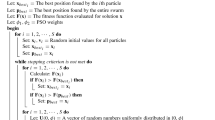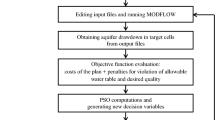Abstract
An optimal pumping policy ensures the sustainability of groundwater resources when groundwater is extracted. In this paper, several simulation models (genetic algorithms, particle swarm optimization and firefly algorithm) are used to evaluate optimal pumping policy in an hypothetical aquifer. In this study, the level of groundwater in an unconfined hypothetical aquifer with a surface area of 1.5 km2 and three different hydraulic conductivities with a thickness of 100 m, as well as four pumping wells were investigated. The finite element method was employed to estimate the groundwater level of the aquifer and the mentioned algorithms were used to optimize the position of the pumping wells. The position of the pumping wells with a specific discharge is optimized to minimize groundwater drawdown in the aquifer. The results indicated that with increasing number of iterations, there was little improvement in the results of the FA, and after five iterations, the algorithm entrapped in local optima. By investigating the values of the objective function of two other algorithms (PSO and GA), the results indicated that the GA has a better performance than the PSO in optimizing groundwater pumping well locations. As a result, the GA reduces the value of objective function by 31% compared to the PSO algorithm. With this value of objective function, the maximum drawdown groundwater was about 2.5 m in the southwest of aquifer. The results indicated that the optimum location of wells is on the western side of the aquifer where the aquifer boundary has a constant head on this side.






Similar content being viewed by others
References
Ayvaz MT, Karahan H (2008) A simulation/optimization model for the identification of unknown groundwater well locations and pumping rates. Journal of Hydrology 357:76–92
Babbar-Sebens M, Minsker BS (2012) Interactive genetic algorithm with mixed initiative interaction for multi-criteria ground water monitoring design. Applied Soft Computing 12:182–195
Bear J (1979) Hydraulics of groundwater. Courier Corporation,
Craig JR, Rabideau AJ (2006) Finite difference modeling of contaminant transport using analytic element flow solutions. Advances in Water Resources 29(7):1075–1087
Cyriac R, Rastogi AK (2016) Optimization of pumping policy using coupled finite element-particle swarm optimization modelling. ISH Journal of Hydraulic Engineering 22(1):88–99
Eberhart R, Kennedy J (1995) A new optimizer using particle swarm theory. In: micro machine and human science, MHS'95, proceedings of the sixth international symposium on, 1995. IEEE, pp 39-43
Famiglietti J et al. (2011) Satellites measure recent rates of groundwater depletion in California's Central Valley Geophysical Research Letters 38
Gautam D, Prajapati R N (2014) Drawdown and dynamics of groundwater table in Kathmandu valley, Nepal The Open Hydrology Journal 8
Gill MK, Kaheil YH, Khalil A, McKee M, Bastidas L (2006) Multiobjective particle swarm optimization for parameter estimation in hydrology Water Resources Research 42
Gray WG, Pinder GF, Brebbia CA (1977) Finite elements in water resources-Proceedings of a conference.
Guo X, Hu T, Wu C, Zhang T, Lv Y (2013) Multi-objective optimization of the proposed multi-reservoir operating policy using improved NSPSO Water resources management 27:2137–2153
Izquierdo J, Montalvo I, Pérez R, Tavera M (2008) Optimization in water systems: a PSO approach. In: Proceedings of the 2008 Spring simulation multiconference. Society for Computer Simulation International, pp 239–246
Ketabchi H, Ataie-Ashtiani B (2015) Evolutionary algorithms for the optimal management of coastal groundwater: a comparative study toward future challenges. Journal of Hydrology 520:193–213
Nagesh Kumar D, Janga Reddy M (2007) Multipurpose reservoir operation using particle swarm optimization. Journal of Water Resources Planning and Management 133:192–201
Patel S, Rastogi AK (2019) Groundwater estimation using global strong form collocation-based Meshfree method in a field like synthetic confined aquifer domain. KSCE J Civ Eng 23(6):2803–2810
Peralta RC, Forghani A, Fayad H (2014) Multiobjective genetic algorithm conjunctive use optimization for production, cost, and energy with dynamic return flow. J Hydrol 511:776–785
Pinder GF, Gray WG (2013) Finite element simulation in surface and subsurface hydrology. Elsevier
Pokrajac D, Lazic R (2002) An efficient algorithm for high accuracy particle tracking in finite elements. Advances in Water Resources 25:353–369
Pour OMR, Zeynali MJ (2015) Application of an max-min ant system algorithm for optimal operation of multi-reservoirs (case study: Golestan and Voshmgir reservoir dams). International Journal of Agriculture and Crop Sciences 8(1):27
Prickett TA (1979) Ground-Water Computer Models—State of the Art Groundwater 17:167–173
Saadatpour M, Afshar A (2013) Multi objective simulation-optimization approach in pollution spill response management model in reservoirs. Water Resources Management 27:1851–1865
Sadeghi-Tabas S, Samadi SZ, Akbarpour A, Pourreza-Bilondi M (2017) Sustainable groundwater modeling using single-and multi-objective optimization algorithms. Journal of Hydroinformatics 19:97–114
Scanlon B, Reedy R, Gates J (2010) Effects of irrigated agroecosystems: 1. Quantity of soil water and groundwater in the southern High Plains, Texas Water Resources Research 46
Steward DR, Allen AJ (2013) The analytic element method for rectangular gridded domains, benchmark comparisons and application to the High Plains Aquifer. Advances in Water Resources 60:89–99
Strack O, Fitts C, Zaadnoordijk W (1987) Application and demonstration of analytic element models
Vrugt JA, Gupta HV, Bastidas LA, Bouten W, Sorooshian S (2003) Effective and efficient algorithm for multiobjective optimization of hydrologic models Water Resources Research 39
Vrugt JA, Robinson BA (2007) Improved evolutionary optimization from genetically adaptive multimethod search. Proceedings of the National Academy of Sciences 104(3):708–711
Wang HF, Anderson MP (1995) Introduction to groundwater modeling: finite difference and finite element methods. Academic Press,
Yang XS (2010) Firefly algorithm, stochastic test functions and design optimisation. arXiv preprint arXiv:1003.1409.
Zambrano-Bigiarini M, Rojas R (2013) A model-independent Particle Swarm Optimisation software for model calibration. Environmental Modelling & Software 43:5–25
Zeynali MJ, Shahidi A (2018) Performance assessment of grasshopper optimization algorithm for optimizing coefficients of sediment rating curve. AUT Journal of Civil Engineering 2(1):39–48
Zhang Z, Jiang Y, Zhang S, Geng S, Wang H, Sang G (2014) An adaptive particle swarm optimization algorithm for reservoir operation optimization. Applied Soft Computing 18:167–177
Author information
Authors and Affiliations
Corresponding author
Additional information
Publisher’s Note
Springer Nature remains neutral with regard to jurisdictional claims in published maps and institutional affiliations.
Rights and permissions
About this article
Cite this article
Akbarpour, A., Zeynali, M.J. & Nazeri Tahroudi, M. Locating Optimal Position of Pumping Wells in Aquifer Using Meta-Heuristic Algorithms and Finite Element Method. Water Resour Manage 34, 21–34 (2020). https://doi.org/10.1007/s11269-019-02386-6
Received:
Accepted:
Published:
Issue Date:
DOI: https://doi.org/10.1007/s11269-019-02386-6




